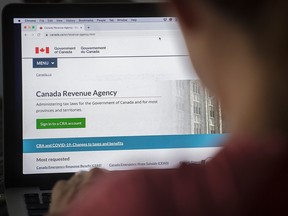Jamie Golombek: Choosing the wrong payment option can lead to arrears interest and even instalment penalties
Reviews and recommendations are unbiased and products are independently selected. Postmedia may earn an affiliate commission from purchases made through links on this page.
Article content
Approximately two million Canadians are required to pay their fourth and final 2022 tax instalment on Dec. 15, and while there are three different options to choose from in determining how much you need to pay each quarter, choosing the wrong option can lead to arrears interest and even instalment penalties, as one couple found out in a case recently decided in Tax Court.
Advertisement 2
Article content
But before jumping into the details of the case, let’s review the tax instalment system. Under the Income Tax Act, quarterly tax instalments are required for this tax year if your net tax owing for 2022 will be more than $3,000 ($1,800 for Quebec tax filers) and was also greater than $3,000 ($1,800 for Quebec) in either 2021 or 2020.
Article content
The three options that may be used to determine how much you need to pay each quarter are: the no-calculation option, the prior-year option and the current-year option. Taxpayers are free to choose the method that results in the lowest payments. But if you choose to pay less than the no-calculation option, you could face instalment interest and a penalty if your instalment amounts are too low or paid late.
Advertisement 3
Article content
Under the no-calculation option, the Canada Revenue Agency calculates your March 2022 and June 2022 instalments based on 25 per cent of the net tax owing from your 2020 assessed return. The Sept. 15 and Dec. 15, 2022 instalments are then calculated based on the net tax owing from your 2021 return, less the March and June payments.
The prior-year option bases the calculation solely on last year’s income, so your 2022 instalments are based on your paying one quarter of the 2021 tax owing on each instalment date. This option is best if your 2022 income, deductions and credits will be similar to 2021, but significantly different than 2020.
Finally, the current-year method lets you base this year’s instalments on the amount of estimated tax you think you will owe for the current year, and you pay one quarter of the estimated amount on each instalment date.
Advertisement 4
Article content
This option is useful if your 2022 income will be significantly less than 2021. But it’s also the riskiest method because if you’re wrong, you can end up being charged instalment interest, compounded daily at the prescribed interest rate (currently, seven per cent for overdue taxes), and even an instalment penalty if the instalment interest is more than $1,000. That’s what happened in this most recent case involving an Alberta couple.

The husband and wife were each required to make instalments for the 2019 tax year because their net tax owing exceeded $3,000 in the previous three taxation years. They received written instalment reminders from the CRA, outlining the three instalment options.
Rather than relying on the no-calculation option, the couple used the current-year method based on an estimate of their 2019 income and estimated tax owing. But in late November 2019, the couple’s holding company declared a dividend in the amount of $600,000, or $300,000 for each of them. They declared this dividend to themselves due to “budget chatter … concerning the possible alteration of (the) tax treatment of Canadian dividend income.”
Advertisement 5
Article content
According to the couple, this pre-budget speculation “created an unforeseen urgency, necessity and desirability to declare the dividend.” This, in turn, “materially increased both (the couple’s) incomes and related tax liability, and correspondingly their respective tax instalments.”
Although the taxpayers each paid large Dec. 15 instalments to make up for the discrepancy between the no-calculation and current-year options, the CRA assessed arrears interest and an instalment penalty for insufficient instalments in the first three quarters.
In court, the taxpayers argued that no arrears interest should be applied to the amounts owing for the March, June and September instalments because they did not expect to incur a sudden influx of income later in the year at the time those quarterly payments were made. As a result, it would have been impossible to make payments based on unknown future information.
Advertisement 6
Article content
The CRA argued that by not selecting the no-calculation option, and not paying the ultimate tax payable in equal instalments over the course of the year, the couple “authored a quarterly instalment deficiency divergent from the no-calculation option. As such, interest and the penalty … (were) correctly calculated and assessed.”
The problem with the CRA’s position, according to the judge, was that “the only safeguard against factually unforeseen or unanticipated increases in income and (tax) liability in the latter part of the year, which skew instalments, is taxpayer choice in the early part of the year of the no-calculation option.” In other words, the no-calculation option essentially becomes the only safe option “unless clairvoyant taxpayer certainty exists.”
Advertisement 7
Article content
-

December is the time to check your RESP withdrawal strategy to help cut any taxes
-

Here’s what you need to know to get Canada’s new dental benefit and housing top-up
-

The CRA is already challenging real estate transactions ahead of new anti-flipping rules
-

If you disagree with a CRA assessment, make sure you file an objection on time — or else
The judge said there may be situations when a taxpayer could establish they had a probable reason to believe their total income for the year would be lower than the no-calculation option, and that the event which led to the resulting insufficient quarterly instalments was “beyond foreseeability and impossible to discern until occurrence.” This embraces the maxim “lex non cogit ad impossibilia,” or legislation cannot be interpreted to require the impossible.
Advertisement 8
Article content
Unfortunately for this couple, the above maxim did not apply because they “were not asked to do the impossible.” Rather, they made a deliberate choice to declare the dividend, which was entirely within their control. The sizable year-end dividend was “a textbook, end-of-year provisional tax plan. It was neither unavoidable nor extraneously circumstantial.” In reality, the taxpayer “conceived, effected and completed it, all by his own hand and effort.”
The judge, in dismissing the couple’s appeal and upholding the arrears interest and instalment penalty, concluded, “While the law may not interpret legislation to require the impossible, it does not accommodate a precautionary step of a tax plan, rendered moot by a legislative path not taken.”
Jamie Golombek, CPA, CA, CFP, CLU, TEP, is the managing director, Tax & Estate Planning with CIBC Private Wealth in Toronto. Jamie.Golombek@cibc.com
_____________________________________________________________
If you liked this story, sign up for more in the FP Investor newsletter.
_____________________________________________________________




